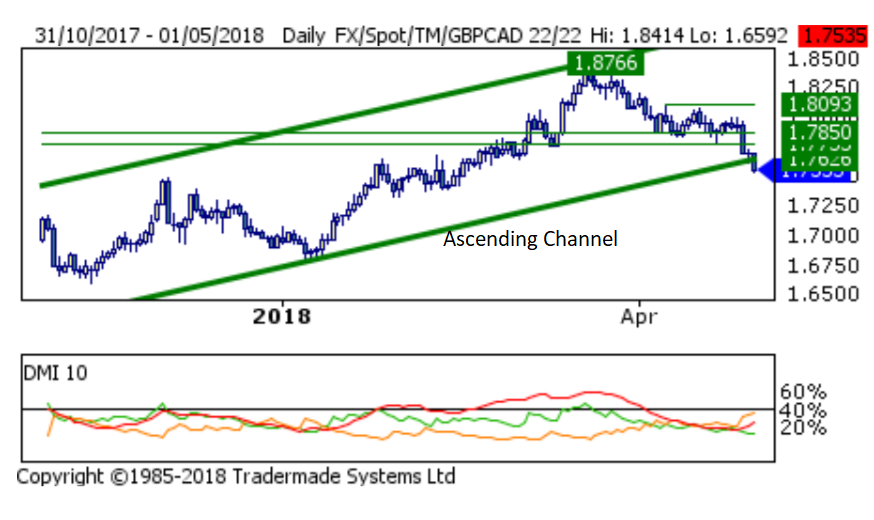The Pound-to-Canadian Dollar Rate is Falling On Diverging Outlooks For Growth
- GBP/CAD has crossed a bearish line on the chart after UK and Canadian growth diverged in Q1
- The pair is vulnerable to deeper weakness to a possible target in the lower 1.70s
- Canadian data is surprising to the upside; UK data to the downside

© thanasak, Adobe Stock
The Pound-to-Canadian Dollar rate has broken lower due to diverging narratives on growth which favour the Canadian rather than the Pound side of the pair.
GBP/CAD has broken below key technical levels too, which suggests further bearish follow-through.
A major driver of FX markets is interest rate expectations because foreign capital tends to flow to where it can earn the most interest.
The outlook for Canadian interest rates, set by the Bank of Canada (BOC), widely diverges with that of UK interest rates, set by the Bank of England (BOE), which is much more depressed.
The Canadian Dollar - known by traders as the 'Loonie' - strengthened recently after the BOC governor Stephen Poloz said, on Tuesday evening, that interest rates in Canada were too low (he said they were below the 'neutral rate', which is the ' just right' rate for the economy), thus inferring a heightened chance of a hike.
This couldn't be more different from the situation in the UK where the governor of the BOE informed two weeks ago that a much-anticipated hike in May might be delayed as there were 'plenty of other meetings' at which the bank could raise rates instead.
The stark contrast does not end there. First quarter Canadian GDP data came out at 0.4%, which was well above expectations, whilst Q1 UK GDP data came out at 0.1% and well below expectations.
Sterling fell further after an initial excuse that soft Q1 GDP was as a result of the bad weather, was later dismissed.
Recent lower-than-expected PMI, consumer credit and GDP data out of the UK has further weakened the Pound and delayed the time when the BOE is likely to raise interest rates.
Whilst BOC governor was not totally hawkish (in favour of higher interest rates) saying that he was concerned about the impact of higher interest rates on the high indebtedness of Canadian households his tone was nevertheless taken as overall positive about the outlook for the economy.
"In a speech that began with a Shakespeare quote, Governor Poloz's remarks today offered something for everyone. Hawks will latch on to the comments suggesting that the current rate of interest is well below the economy's neutral rate and that the central bank has become more confident in the outlook. But doves will focus on comments reiterating that high levels of household debt mean that rate hikes are more powerful this cycle and that the Bank needs to closely monitor the response to higher rates of some of the most vulnerable households in Canada," says Royce Mendes, an analyst at Pantheon Macroeconomics.
Clearly, risks from exogenous factors affect both currencies, with the Loonie subject to a NAFTA premium and the UK equally to Brexit Irish border shenanigans.
The cold objectivity of the charts indicates a bias for further weakness.
"The extent of the GBP’s slide is now becoming pronounced. We thought the loss of support at 1.7850 was significant but the loss of weekly trend channel support risks turning the recent decline into a rout," says Shaun Osborne, chief FX strategist at Scotiabank.

Osborne argues that the correction from the March 1.84 peak has not actually fallen that far relative to the long previous rally from the September 2017 lows, and is, therefore, probably unfinished.
Analysts have found that corrections of the main trend often tend to be at least 38.2%, 50.0% or 61.8% of the previous trend, and Osborne makes the observation that the current correction has now even fallen 38.3% of the previous trend, so may well decline further, possibly even to the 50% level at 1.7127, since prices often retrace 50% of the previous trend.
The chart above shows the pair starting to break down out of an ascending channel. Such breakdowns tend to fall as far as the height of the channel extrapolated lower, which suggests a substantially lower exchange rate of 1.70, perhaps.
1.70 - or thereabouts - also happens to be where the 200-day and 50-week MAs are situated. The 50-week is shown on the chart below. Prices often stall at major moving averages and because of this, they make useful targets.
Get up to 5% more foreign exchange by using a specialist provider to get closer to the real market rate and avoid the gaping spreads charged by your bank when providing currency. Learn more here.










